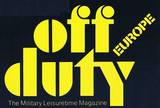"off duty" 1970 - 1997 - eine Freizeit-Zeitung für's US-Militär
Die in diesem amerikanischen (Freizeit-) Shopping-Magazin angepriesenen Hifi- und Video-Produkte waren auschließlich amerikanischen und kanadischen Militärangehörigen zugänglich - also zu kaufen - und vor allem zu ganz ungewöhnlich (verblüffend) niedrigen US $ Military-Preisen. Zu der einführenden "off duty" Seite geht es hier lang. - Um 1970 begann der weltweite Hifi-Boom bis zum 1. Crash 1978 und dann wieder zum 2.Crash um 1990. Über die 20 Jahre nach 2001 lesen Sie mehr in den Kolumnen auf diesen japanischen Seiten.
.
Your Hi-Fi's Heart
You cant beat today's receivers, tuners and integrated amplifiers - By LARRY MYERS - Off Duty / Europe / November 1975
.
Receivers
.
"Receiver" tun so, als ob sie nicht viel tun.
JUDGING BY APPEARANCE ONLY, receivers don't seem like they are accomplishing much. You can see a turntable go'round, or the reels of a tape recorder, and speakers certainly make their presence known, but a receiver?
It just sits there, handsome but mute, with only an occasional flicker of a light to let you know that it is doing something. But doing something it is, performing a multitude of functions that make other components seem like slackers by comparison.
Receiver haben 3 Funktionen
Receivers, in fact, contain electronic circuitry that performs three distinct functions. For starters, the tuner section receives AM, FM and FM-stereo broadcasts.
Next, preamplifier circuits amplify signals from the tuner circuit or other inputs (such as a turntable) and provides necessary controls for volume, tone and so on.
Then, the power amplifier section makes these signals strong enough to drive your loudspeakers.
Der 4-channel receiver hat noch etwas mehr drinnen
Now, if you are talking about a 4-channel receiver, you've also got to include decoder and/or demodulator circuitry, additional preamplifier controls and two more amplifier channels. When you consider that all of this miniaturized electronic circuitry fits into a cabinet about the size of a briefcase, you come to realize that receivers have a lot going for them.
Der "connoisseur" mag die getrennten Geräte
The same electronic advances that made the modern receiver a reality have also been put to good use in separate tuners (which "receive" radio broadcasts, period) and integrated amplifiers (which combine preamp and power amps on one chassis).
For those who prefer separate components, the choice ranges from ultra-compact individual units to highly elaborate (and costly) equipment for the connoisseur. Regardless of which you prefer, the following paragraphs should help in choosing a new receiver, tuner or integrated amplifier.
Amplifiers
.
Preamplifiers
The preamplifier section of your receiver or integrated amplifier increases the voltage of incoming signals from the phono cartridge, tuner, tape deck or other source to the level required by the power amplifier. In addition, preamps contain equalization and control circuits to help tailor the final sound to your liking.
The array of tone controls on the latest equipment is more sophisticated than ever before. Many units now offer, in addition to bass and treble, a mid-range control, or even a built-in equalizer that divides the audio spectrum into several bands to provide additional freedom in matching the sound to your taste ortothe characteristics of your listening room.
Also more elaborate in many late models are the tape monitoring facilities. Many receivers allow you to connect two tape recorders (one open-reel and one cassette unit, for example) and provide separate monitoring and dubbing circuits for each, a big help when copying tapes.
And, of course, provisions for 4-channel sound are very much in evidence. They range from 4-channel systems that will handle any quad sound source to relatively simple models that produce a "pseudo" quad effect. The better ones naturally contain more sophisticated circuitry and provide more control features.
.
Power amplifiers (und die neuen Bestimmungen der FTC)
The power amp, whether part of a receiver or an integrated amplifier, boosts the signal from the preamplifier to a level powerful enough to drive loudspeakers.
Under a new U.S. Federal Trade Commission (FTC) ruling enacted last year (das war also in 1974), makers of amplifiers and receivers must rate their equipment using standardized test procedures.
Advertising materials must tell you the sine wave continuous power output per channel, with all channels driven, measured at the stated impedance at which the equipment is designed to operate. Also stated must be the range of frequencies (bandwidth) over which the power level is maintained, as well as the maximum total harmonic distortion at all power levels from 1/4 watt to full power.
This information will be a big help to consumers in evaluating amplifiers, and the word is that the FTC plans strict enforcement of the regulations. Because of the exacting nature of the rating procedures, some manufacturers have not yet issued updated figures on every piece of equipment.
We've included all those received thus far. As the remaining still carry their previous ratings, we include below an explanation of the criteria that applied before enactment of the FTC ruling.
Frequency response.
A good amplifier covers the audio spectrum with a minimum of variation. In other words, at a given amount of power it should amplify all frequencies equally - within one or two decibels (±1dB). Frequency response is usually measured at normal listening levels which under average conditions represent about one or two watts. At higher power levels a really "flat" response is more difficult to achieve and such an amplifier is likely to cost more. Here the FTC power rating, with its statement of bandwidth, really tells the story.
IHF power bandwidth.
This measure follows standards set up by the Institute of High Fidelity (IHF). It represents the range of frequencies over which the amplifier can deliver at least 50 per cent of its rated power.
"Half power," incidentally, is a reduction of just 3dB with sharp peaks at some frequencies and dips in the response curve at other frequencies.
Distortion.
The distortion figures tell whether an amplifier does anything to the signal other than amplify it. Usually, both harmonic distortion and intermodulation (IM) distortion are given. Figures lower than one per cent are considered acceptable. For a truly meaningful rating, look for harmonic distortion measurements at more than one frequency. Like the power rating, the spec is likely to be more impressive at a mid-frequency than at the extremes of the audio spectrum.
Hum and noise.
All amplifiers add signals of their own to your input signal. You can hear this by turning up the volume control on your amplifier without putting any signal into it. The hum and noise specification tells you how much extraneous sound the amplifier produces in relation to the outputsignal. Lookfora rating ofa least-60 dB and an even better -70 dB rating if you plan to do a lot of tape recording. Make sure that the rating is taken through the phono input and therefore includes the preamp (where most of the noise is added).
Tuners
.
The information in this section applies to the tuner section of a receiver as well as to a separate tuner.
Sensitivity. Usually expressed in microvolts (uV), FM tuner sensitivity figures tell you how strong a station's signal must be before it can be heard above normal FM background noise. 1.5 to 3 uV is a common range for such figures. The usual "IHF sensitivity" specification is based on a 30 dB difference between the noise level and the station's signal level. Unfortunately, this 30 dB difference leaves a lot to be desired if you are at all serious about your listening. Some manufacturers now rate their tuners at a more acceptable 50 dB quieting level, which usua lly yields a sensitivity figure of 3-7 uV. However, manufacturers are not required to provide this rating so few do.
Signal-to-noise (S/N) ratio.
Diese Info ist nicht mehr wichtig.
.
Dolby. (eine Eklärung des US-UKW-Dolby's)
Because of the noise that is an inevitable byproduct of FM transmission and reception, FM signals are normally broadcast with boosted (pre-emphasized) high frequencies. FM tuners have circuitry to decrease (de-emphasize) this boost in order to restore frequency balance while suppressing noise.
In the U.S., normal pre and de-emphasis begins at 2,120 Hz, although it is often expressed in a time-related fashion as 75 microseconds. To further reduce background noise, the Dolby Noise Reduction System is being adopted by many FM broadcasters in the U.S.
Dolbyized FM signals contain even a greater boost in high frequencies than FM signals, but the boost at the transmitter isn't begun until 6,360 Hz or 25 microseconds. This change in the pre and de-emphasis frequency insures that a Dolbyized signal will sound acceptable on a conventional 75-microsecond de-emphasis FM tuner.
A tuner with Dolby, however, switches automatically to the new 25-microsecond de-emphasis to match that of the Dolby FM transmission.
Coupled with the tuner's Dolby circuitry, this produces a balanced frequency response and a reduction in noise some 10 dB better than that of a non-Dolby receiver. Dolby-equipped tuners and receivers are beginning to appear on the military market. In addition, some tape decks with Dolby now have a special switch to compensate for the 25 microsecond de-emphasis used with Dolby FM.
Alternate channel selectivity and capture ratio. These specifications tell you how effectively the tuner separates the many stations on the dial. To prevent interference from stations broadcasting next to the station you want, a receiver should have a selectivity figure of not less than 40 dB. And to suppress signals from more distant stations on the same channel, the tuner should have an IHF capture ratio of less than 3 dB.
.
Harmonic distortion.
In FM tuners, follow the same principles applied in amplifiers-under one per cent THD is acceptable. Be aware that distortion is higher in stereo reception than in mono, so when making comparisons always consider the same mode of operation.
Stereo separation.
This figure indicates the effectiveness of the multiplex decoder, telling you how much difference there is between the signals heard in the left and right channels. Many makers give a separation figure taken at one frequency, usually a mid-frequency that is the optimum separation point for their equipment. Look for separation figures at more than one frequency, or better yet, over a broad range of frequencies. If the reference frequency is 400 or 1k Hz, expect a figure of 35 dB or more. If the rating is made over a broader range of frequencies, the figure may be lower, say 30dB or so.
.
Miscellaneous.
In an increasing number of tuners there are solid-state tuning devices that eliminate the mechanical linkages and variable tuning capacitors that have traditionally been used. In the most expensive models of this type, new integrated circuits synthesize with extreme accuracy the frequencies needed for tuning via voltage-controlled diodes. In these tuners, digital frequency readouts are commonly used. There are also some tuners available that feature digital readout but use conventional tuning circuits.
.


